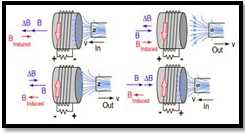Question 3: Describe Lenz’s Law. Show that this law is a manifestation of conservation of energy?
ANSWER
Lenz’s Law
“The induced emf produced in a coil always opposes the cause due to which it is produced.”
Illustration and examples of Lenz’s Law

See the illustration. We set the magnet in motion relative to the coil. Suppose the N pole of the magnet is moved toward the coil. The distance between the coil and magnet decreases. The flux linking the coil changes (increases), thereby, inducing an emf in the coil (Faraday’s Law). It is observed that the induced current is produced in the direction that its magnetic field (as current in a wire is associated with a magnetic field around it) opposes the motion of the magnet toward the coil. As the N pole of the magnet is moved towards the coil (leftward) the field of the induced current must point rightward. This makes the face of the coil facing the magnet as N pole, too. By applying RHR, the current must move anti-clock wise in the wire (from the approaching magnet side).
Now if the same pole of the magnet is withdrawn (i.e, moved away) the flux through the coil decreases (because the number of lines passing the coil decrease as the magnet is moved away) and the induced current in the coil will move in a direction to maintain the same conditions of the flux (i.e, will resist to decrease the number of lines passing through the coil). This means the induced current in the circuit will move clock-wise, making the face close to the magnet an S-pole (RHR)(because the opposite poles attract the lines of force to one another).
Example 2:The same method can be applied to assess the effect of moving/withdrawing the south pole of the magnet to a coil. (do it yourself!).The result obtained is the same, that is, the induced current move in a direction to oppose the cause of change in flux through it.
Similarly, if we consider two coils, a primary (in which current is set up to produce a magnetic field) and a secondary (in which current is induced), and move them towards or away from each other the induced current will move in a direction to oppose the relative motion of the coils.
Lenz’s Law as manifestation of conservation of energy:
Lenz’s Law support the law of conservation of energy, i-e, energy can neither be created nor destroyed but changed from one form to another.
Actually, a changing magnetic field inducing an emf and hence a current in the circuit. The direction of the induced current is such that it opposes the cause of changing magnetic flux. The cause is actually the magnet in motion whose flux links the coil. The work done against the opposing magnetic field is transformed into electrical energy. Therefore, the energy remains conserved.
Now if the magnet produced by the induced current had opposite direction to the permanent magnet, the two opposite magnets (permanent and induced) would attract each other (which is against the Lenz law). This would increase the velocity of the incoming magnet and the rate of change of flux accordingly. The induced current would increase which would further increase the strength of its magnet and the process would go on with the result of producing a huge current without spending energy. This is contrary to the law of conservation of energy.
Hence the violation of Lenz’s law results in the violation of the law of conservation of energy.

Pingback:magnet-dropped-in-metal-tube – msa
Pingback:Comprehensive Questions on Electromagnetic Induction, Physics 12 … msa – msa
Pingback:mutual-induction-its-coefficient – msa
Pingback:faradays-law – msa